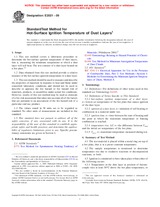Wir benötigen Ihre Einwilligung zur Verwendung der einzelnen Daten, damit Sie unter anderem Informationen zu Ihren Interessen einsehen können. Klicken Sie auf "OK", um Ihre Zustimmung zu erteilen.
ASTM E2021-09
Standard Test Method for Hot-Surface Ignition Temperature of Dust Layers
Automatische name übersetzung:
Standard Test Method for Hot - Oberfläche die Zündtemperatur der Staubschichten
NORM herausgegeben am 1.12.2009
Informationen über die Norm:
Bezeichnung normen: ASTM E2021-09
Anmerkung: UNGÜLTIG
Ausgabedatum normen: 1.12.2009
SKU: NS-43992
Zahl der Seiten: 10
Gewicht ca.: 30 g (0.07 Pfund)
Land: Amerikanische technische Norm
Kategorie: Technische Normen ASTM
Die Annotation des Normtextes ASTM E2021-09 :
Keywords:
dust layer ignition, hot surface ignition, ignition temperature, Dust, Dust layers, Hot-surface testing/evaluation, Ignition, ICS Number Code 13.230 (Explosion protection)
Ergänzende Informationen
| Significance and Use | ||||||||||
|
This test method is applicable to dusts and powders, and provides a procedure for performing laboratory tests to evaluate hot-surface ignition temperatures of dust layers. The test data can be of value in determining safe operating conditions in industrial plants, mines, manufacturing processes, and locations of material usage and storage. Due to variation of ignition temperature with layer thickness, the test data at one thickness may not be applicable to all industrial situations (see Appendix X1). Tests at various layer thicknesses may provide a means for extrapolation to thicker layers, as listed in the following for pulverized Pittsburgh bituminous coal dust (2). Mathematical modeling of layer ignition at various layer thicknesses is described in Ref. (3).
This hot plate test method allows for loss of heat from the top surface of the dust layer, and therefore generally gives a higher ignition temperature for a material than Test Method E771, which is a more adiabatic system. This test method for dust layers generally will give a lower ignition temperature than Test Method E1491, which is for dust clouds. The layer ignition temperature is determined while monitoring for periods of minutes to hours, while the dust cloud is only exposed to the furnace for a period of seconds. Note 1—Much of the literature data for layer ignition is actually from a basket in a heated furnace (4), known as the modified Godbert-Greenwald furnace test. Other data are from nonstandardized hot plates (5-9). Additional information on the significance and use of this test method may be found in Ref. (10). |
||||||||||
| 1. Scope | ||||||||||
|
1.1 This test method covers a laboratory procedure to determine the hot-surface ignition temperature of dust layers, that is, measuring the minimum temperature at which a dust layer will self-heat. The test consists of a dust layer heated on a hot plate. , 1.2 Data obtained from this test method provide a relative measure of the hot-surface ignition temperature of a dust layer. 1.3 This test method should be used to measure and describe the properties of materials in response to heat and flame under controlled laboratory conditions and should not be used to describe or appraise the fire hazard or fire hazard risk of materials, products, or assemblies under actual fire conditions. However, results of this test method may be used as elements of a fire risk assessment that takes into account all of the factors that are pertinent to an assessment of the fire hazard risk of a particular end use product. 1.4 This standard does not purport to address all of the safety concerns, if any, associated with its use. It is the responsibility of the user of this standard to establish appropriate safety and health practices and determine the applicability of regulatory limitations prior to use. Specific precautionary statements are given in Section 8. |
||||||||||
| 2. Referenced Documents | ||||||||||
|
Empfehlungen:
Aktualisierung der technischen Normen
Wollen Sie sich sicher sein, dass Sie nur die gültigen technischen Normen verwenden?
Wir bieten Ihnen eine Lösung, die Ihnen eine Monatsübersicht über die Aktualität der von Ihnen angewandten Normen sicher stellt.
Brauchen Sie mehr Informationen? Sehen Sie sich diese Seite an.




 Cookies
Cookies
